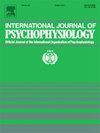Event-related potentials and presaccadic activity in response to affective stimuli in participants with obsessive-compulsive disorder
IF 2.6
3区 心理学
Q3 NEUROSCIENCES
引用次数: 0
Abstract
Individuals with obsessive-compulsive disorder (OCD) have difficulty with regulating their emotions and show reduced functioning of inhibitory control. It was reported previously that OCD patients had delayed antisaccade response and increased error rate only when affective pictures with negative valence served as fixation stimuli in “the antisaccade emotional fixation task”. Complementary to the previous research, eye movements and late positive potential (LPP) for fixation stimuli and the presaccadic positivity (PSP) and spike potential (SP) before saccade onset, were compared in two groups of OCD and healthy volunteers. Both groups exhibited increased fixation on emotional images, particularly on unpleasant ones, and showed heightened LPP responses without significant between-group differences. However, individuals with OCD had lower PSP and SP amplitudes for unpleasant images compared to the control group, although there were no differences within conditions for each group. These results suggest that while both groups displayed similar effects of unpleasant images on the involuntary orientation of attention, the findings on presaccadic potentials correlate with behavioral data on increased error rate in antisaccade tasks in OCD. This suggests that emotional dysregulation may contribute to impaired inhibitory control in individuals with OCD.
强迫症患者对情感刺激做出反应的事件相关电位和前触活动
强迫症(OCD)患者很难调节自己的情绪,并表现出抑制控制功能减退。之前有报道称,强迫症患者只有在 "反施法情绪定格任务 "中以带有负面情绪的图片作为定格刺激时,才会出现反施法反应延迟和错误率增加的情况。作为对之前研究的补充,研究人员比较了两组强迫症患者和健康志愿者的眼球运动、对固定刺激的晚期正电位(LPP)以及囊回开始前的前积聚正电位(PSP)和尖峰电位(SP)。结果显示,两组患者对情绪图像,尤其是不愉快图像的固着都有所增加,LPP 反应也有所增强,但组间差异不明显。然而,与对照组相比,强迫症患者对不愉快图像的 PSP 和 SP 振幅较低,尽管各组在不同条件下没有差异。这些结果表明,虽然两组患者都表现出不愉快图像对注意力非自主定向的类似影响,但强迫症患者的前累积电位发现与反累积任务中错误率增加的行为数据相关。这表明情绪失调可能会导致强迫症患者的抑制控制能力受损。
本文章由计算机程序翻译,如有差异,请以英文原文为准。
求助全文
约1分钟内获得全文
求助全文
来源期刊
CiteScore
5.40
自引率
10.00%
发文量
177
审稿时长
3-8 weeks
期刊介绍:
The International Journal of Psychophysiology is the official journal of the International Organization of Psychophysiology, and provides a respected forum for the publication of high quality original contributions on all aspects of psychophysiology. The journal is interdisciplinary and aims to integrate the neurosciences and behavioral sciences. Empirical, theoretical, and review articles are encouraged in the following areas:
• Cerebral psychophysiology: including functional brain mapping and neuroimaging with Event-Related Potentials (ERPs), Positron Emission Tomography (PET), Functional Magnetic Resonance Imaging (fMRI) and Electroencephalographic studies.
• Autonomic functions: including bilateral electrodermal activity, pupillometry and blood volume changes.
• Cardiovascular Psychophysiology:including studies of blood pressure, cardiac functioning and respiration.
• Somatic psychophysiology: including muscle activity, eye movements and eye blinks.

 求助内容:
求助内容: 应助结果提醒方式:
应助结果提醒方式:


